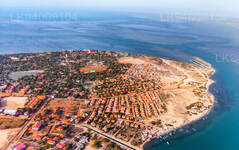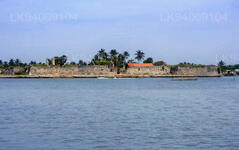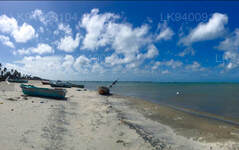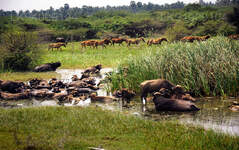
Mannar City
Mannar is the main town of Mannar District, Northern Province, Sri Lanka. It is governed by an Urban Council. The town is located on Mannar Island overlooking the Gulf of Mannar and is home to the historic Ketheeswaram temple.
Mannar-Stadt
Lage: Mannar liegt 325 km nördlich von Colombo
MannarDie reguläre Route von Colombo nach Mannar führt über Anuradhapura und Madawachchiya .
Distrikt Mannar
Der Distrikt Mannar gehört zur Nordprovinz Sri Lankas und besteht aus einem Teil des Festlands und der Insel Mannar – der größten Insel des Landes. Die Straße nach Mannar führt durch die Trockenzone Sri Lankas. Die Landschaft im Distrikt Mannar variiert von bewaldeten Dschungeln über Reisfelder bis hin zu sich wiegenden Palmen.
Mannar Island
Mannar Island ist eine trockene und karge Halbinsel im Distrikt Mannar . Obwohl sie als Inselchen bezeichnet wird, handelt es sich tatsächlich um eine Halbinsel in Form einer Zunge. Talaimannar, die westlichste Spitze der Insel, ist durch ein Korallenriff in der Palkstraße fast mit Dhanuskodi, der östlichsten Spitze der Halbinsel Südindien, verbunden.
Abgesehen von dem schmalen Landstreifen, der die Halbinsel mit dem Festland verbindet, ist die Insel Mannar auch durch einen Damm über das flache Wasser verbunden, der einen 3 km langen Abschnitt der Hauptstraße A14 Madawachchiya – Talaimannar bildet. Der kleine Fischerhafen von Mannar liegt an der Südostküste der Insel.
Die Insel Mannar wurde in der Vergangenheit mit Namen wie „Manthei“, „Mathota“, „Maathiththa“, „Mahaputu“ und „Mawatuthota“ bezeichnet.
Mannar Highlights
St. Mary's Kirche in Madhu
Die St. Mary's Church in Madhu (Heiligtum Unserer Lieben Frau von Madhu) liegt 50 km südöstlich von Mannar. Von der Kreuzung Madhu Road aus sind es 12 km Fahrt (A 378 Madhu Road) landeinwärts von der Hauptstraße A14 Madawachchiya – Talaimannar.
Die im portugiesischen Stil erbaute Kirche aus dem 19. Jahrhundert beherbergt die Statue Unserer Lieben Frau von Madhu, die allen Besuchern Segen bringen soll. Die Statue wurde 1670 von Katholiken nach Madhu gebracht, die vor der Verfolgung durch die Holländer flohen. Das abgelegene Dorf Madhu ist seit über 1860 Jahren auch für Buddhisten heilig, nämlich seit der Zeit von König Gaja Bahu I. (114–136 n. Chr.), der den hinduistischen Pattini-Kult im alten Lanka einführte.
Es ist bemerkenswert, dass der Pattini-Kult nicht in Anuradhapura, der damaligen Hauptstadt und einem ruhmreichen asiatischen akademischen Zentrum des Theravada-Buddhismus, beheimatet war. Der Pattini-Devale-Schrein wurde in Mannar, 90 km nordwestlich von Anuradhapura, errichtet. Während der portugiesischen Herrschaft in Sri Lanka nannten ihn die Hindus Amman Kovil. Der nahegelegene Tank heißt noch heute Kovil Kulam (Tank des Devale), was sich vom tamilischen Namen des Ortes ableitet.
Die Pilger, die Madhu häufig besuchen, kommen hauptsächlich im Glauben an die Heilkräfte der Gottheit Pattini Amma. Auch kinderlose Frauen suchen Pattini Ammas Segen. Mr. EB Denham, der Autor des Zensusberichts von 1911, sagt: „Es handelt sich im Wesentlichen um eine Pilgerfahrt in den Wald. Der Erde von Madhu werden besondere medizinische Eigenschaften zugeschrieben, daher die Heiligkeit, die zu dem Ruf führte, dass die ‚Madhu-Medizin‘ in manchen Fällen Heilung bewirkt. Interessanterweise gab es im Jahr 1911 keine ständigen Bewohner von Madhu. Am 10. März 1911, dem Zensustag, waren nur 320 Pilger in Madhu anwesend, darunter 230 Singhalesen aus Colombo und dem Distrikt Chilaw.“
In seinem Handbuch der Nordzentralprovinz hielt der britische Beamte RW Levers Folgendes fest: „Heutzutage werden die Opfergaben im Allgemeinen zur St. Mary‘s Church in Madhu gebracht, die von den Buddhisten und vielen tamilischen Pilgern, die dorthin kommen, als Tempel von Pattini Amma (Amman Kovil) angesehen wird.“
Mit dem Bau einer Kirche ab 1876 griff der katholische Bischof von Jaffna den jahrhundertealten Glauben an die Heilkräfte von Pattini Amma auf und würdigte damit die Jungfrau Maria des christlichen Glaubens. Für Buddhisten und Hindus ist der Ort jedoch nach wie vor heilig.
Madhu-Fest
Das Madhu-Fest findet Mitte August statt. Am 15. August, dem Tag der Himmelfahrt der Heiligen Jungfrau Maria, werden voraussichtlich über eine halbe Million Gläubige aus ganz Sri Lanka kommen. Am Tag der Himmelfahrt der Heiligen Jungfrau Maria feiert die römisch-katholische Kirche den Tag, an dem die Jungfrau Maria nach Abschluss ihres irdischen Lebens mit Leib und Seele in den Himmel aufgenommen wurde.
About Mannar District
Mannar is the capital of Mannar District, Sri Lanka. Mannar District is located in northwestern Sri Lanka. It is one of five administrative districts of the Northern Province. The district covers 2,002 sq. km, approximately 3% of the total land area of Sri Lanka. Geographically the bulk of Mannar is on the mainland within the arid and dry zone. High temperatures and low rainfall characterize the climate. The monthly temperatures range between 26.5°C and 30.0°C with highs normally recorded between May and August. Mannar receives nearly 60% of its rainfall during the northeast monsoon, which lasts from October through December. The land area is relatively flat and sits at low elevations. Towards the interior the terrain is gently undulating, favoring the storage of rainwater in tanks that provide the majority of the irrigation for the district's arable land. The primary economic activities in Mannar are crop cultivation (mainly paddy), fisheries and animal husbandry. Employment opportunities in the district are highly seasonal, and there are no institutional facilities for tertiary education.
About Northern Province
The Northern Province is one of the 9 provinces of Sri Lanka. The provinces have existed since the 19th century but they didn't have any legal status until 1987 when the 13th Amendment to the 1978 Constitution of Sri Lanka established provincial councils. Between 1988 and 2006 the province was temporarily merged with the Eastern Province to form the North-East Province. The capital of the province is Jaffna.
Northern Province is located in the north of Sri Lanka and is just 22 miles (35 km) from India. The province is surrounded by the Gulf of Mannar and Palk Bay to the west, Palk Strait to the north, the Bay of Bengal to the east, and the Eastern, North Central and North Western provinces to the south. The province has a number of lagoons, the largest being Jaffna Lagoon, Nanthi Kadal, Chundikkulam Lagoon, Vadamarachchi Lagoon, Uppu Aru Lagoon, Kokkilai lagoon, Nai Aru Lagoon, and Chalai Lagoon.Most of the islands around Sri Lanka are to be found to the west of the Northern Province. The largest islands are Kayts, Neduntivu, Karaitivu, Pungudutivu, and Mandativu.
The Northern Province's population was 1,311,776 in 2007. The majority of the populations are Sri Lankan Tamils, with a minority Sri Lankan Moor and Sinhalese population. Sri Lankan Tamil is the major language spoken in the province by the vast majority of the population. The other language spoken is Sinhala by 1 percent of the population. English is widely spoken and understood in the cities.
【Text by Lakpura™. Images by Google, copyright(s) reserved by original authors.】














